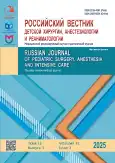Грыжа Амианда у двухмесячного ребенка, рожденного с экстремально низкой массой тела: клинический случай
- Авторы: Перепелкин А.И.1,2, Синицын А.Г.1,2, Копань Г.А.1,2, Шомах А.И.1,2
-
Учреждения:
- Волгоградский государственный медицинский университет
- Клиническая больница скорой медицинской помощи № 7, Волгоград
- Выпуск: Том 15, № 3 (2025)
- Страницы: 423-430
- Раздел: Клинические случаи
- URL: https://medbiosci.ru/2219-4061/article/view/343622
- DOI: https://doi.org/10.17816/psaic1940
- EDN: https://elibrary.ru/BAPIML
- ID: 343622
Цитировать
Полный текст
Аннотация
Грыжа Амианда — это врожденная патология, представляющая собой наличие червеобразного отростка в составе пахового грыжевого мешка, является редкой операционной находкой в педиатрической практике. В статье представлен клинический случай ребенка в возрасте 2 мес., который поступил в детское анестезиолого-реанимационное отделение Клинической больницы скорой медицинской помощи № 7 Волгограда. Пациент из двойни, рожденный с крайней степенью недоношенности (26 нед. гестации) и экстремально низкой массой тела (900 г). В связи с отрицательной динамикой состояния за счет выраженного беспокойства, появления отечности, уплотнения и гиперемии мошонки с распространением на область лобка и правую паховую область, лабораторно выявленной лейкопенией со сдвигом формулы влево, а также нарастанием концентрации С-реактивного белка до 149,2 мг/л. При поступлении в хирургический стационар состояние пациента тяжелое. Температура тела 37,8°C. Сознание было сохранено, на осмотр пациент реагировал болезненным криком. Из неврологических признаков отмечались диффузное снижение мышечного тонуса и рефлекторной активности, слабые рефлексы орального автоматизма и быстро угасающие спинальные рефлексы. Местно в правой пахово-мошоночной области были выявлены отек и гиперемия, границы гиперемии распространялись от кожи мошонки на правый паховый канал и лобковую область. Пальпаторно проекция внутреннего пахового кольца была свободная, дистальнее в пахово-мошоночной области определялось плотно-эластичное образование размерами 4,0×1,5–2,0 см, правое яичко отдельно не выявлено. В левой пахово-мошоночной области отмечалось грыжевое выпячивание до 4,0×3,0 см, свободно вправляющееся в брюшную полость, гиперемии слева нет. В экстренном порядке выполнена герниолапаротомия справа. Содержимым влагалищного отростка являлся червеобразный отросток с булавовидно-расширенной верхушкой до 0,7×0,5 см, пальпаторно флуктуирующей. Выполнена аппендэктомия лигатурным способом. При гистологическом исследовании резецированного червеобразного отростка выявлены признаки острого флегмонозного воспаления. Послеоперационный период протекал гладко. На 4-е сутки ребенок переведен в Волгоградскую областную детскую больницу с рекомендациями планового оперативного лечения по поводу свободной паховой грыжи слева. Описанный клинический случай подчеркивает, что своевременное распознавание, ранняя активная хирургическая тактика и индивидуальный подход к лечению существенно улучшают прогноз. Повышенная настороженность, особенно в условиях недоношенности и полиорганной незрелости, остается ключевым элементом успешной диагностики и лечения данного редкого состояния. В анализируемом случае выполненное оперативное вмешательство позволило своевременно установить диагноз, избежать осложнений, связанных с риском перфорации аппендикса, развитием перитонита и прогрессированием воспалительного процесса мягких тканей пахово-мошоночной области.
Ключевые слова
Полный текст
Открыть статью на сайте журналаОб авторах
Андрей Иванович Перепелкин
Волгоградский государственный медицинский университет; Клиническая больница скорой медицинской помощи № 7, Волгоград
Автор, ответственный за переписку.
Email: similipolai@mail.ru
ORCID iD: 0000-0001-5964-3033
SPIN-код: 5545-8353
д-р мед. наук, профессор
Россия, Волгоград; ВолгоградАлексей Геннадиевич Синицын
Волгоградский государственный медицинский университет; Клиническая больница скорой медицинской помощи № 7, Волгоград
Email: all-sur04@mail.ru
ORCID iD: 0000-0002-8308-8364
SPIN-код: 3223-7231
канд. мед. наук
Россия, Волгоград; ВолгоградГлеб Анатольевич Копань
Волгоградский государственный медицинский университет; Клиническая больница скорой медицинской помощи № 7, Волгоград
Email: gleb.kopan@yandex.ru
ORCID iD: 0000-0002-6627-1028
SPIN-код: 1465-6360
канд. мед. наук, доцент
Россия, Волгоград; ВолгоградАхмад Ибрагим Шомах
Волгоградский государственный медицинский университет; Клиническая больница скорой медицинской помощи № 7, Волгоград
Email: ahmadshomah@yahoo.com
ORCID iD: 0009-0007-5553-4826
Россия, Волгоград; Волгоград
Список литературы
- Suliman A, Elfaki H, Hussein S. Amyand’s hernia in a 2-month-old infant: The first case report from Sudan. Int J Surg Case Rep. 2024;122:110114. doi: 10.1016/j.ijscr.2024.110114
- Ocaña PA, Gonzalez L, Llerena EL, et al. Amyand hernia with acute appendicitis in a patient with ambiguous genitalia: a case report. J Pediatr Surg Case Rep. 2025;117:102992. doi: 10.1016/j.epsc.2025.102992
- Losanoff JE, Basson MD. Amyand hernia: a classification to improve management. Hernia. 2008;12(3):325–326. doi: 10.1007/s10029-008-0331-y
- Kotaluoto S, Ukkonen M, Pauniaho S-L, et al. Mortality related to appendectomy; a population based analysis over two decades in Finland. World J Surg. 2017;41(1):64–69. doi: 10.1007/s00268-016-3688-6
- Sarah-May ML, Anne-Fleur MH, Derikx JPM, et al. Appendicitis and its associated mortality and morbidity in infants up to 3 months of age: A systematic review. Health Sci Rep. 2023;6(9):e1435. doi: 10.1002/hsr2.1435
- Kumar R, Mahajan JK, Rao KLN. Perforated appendix in hernial sac mimicking torsion of undescended testis in a neonate. J Pediatr Surg. 2008;43(4):e9–e10. doi: 10.1016/j.jpedsurg.2007.11.031
- Logan MT, Nottingham JM. Amyand’s hernia: a case report of an incarcerated and perforated appendix within an inguinal hernia and review of the literature. Am Surg. 2001;67(7):628–629. doi: 10.1177/000313480106700705
Дополнительные файлы







